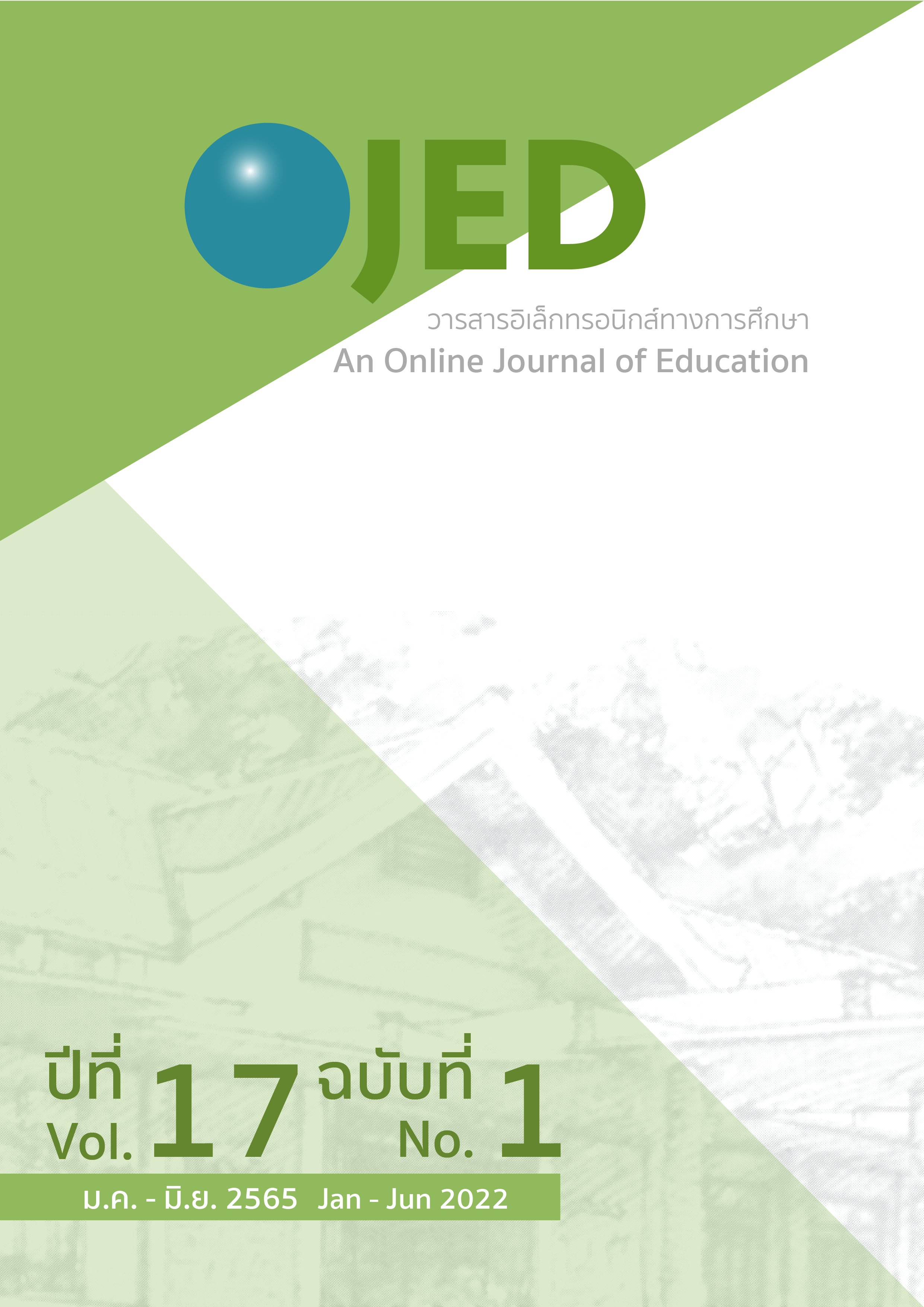Effects of Instruction Based on Intertextuality Theory On Poetic Writing Abilities of Lower Secondary School Students
DOI:
https://doi.org/10.14456/ojed.2022.16Keywords:
intertextuality theory, instruction based on intertextuality theory, poetic writing abilitiesAbstract
The purposes of this research were to 1) compare poetic writing abilities of the students who were taught using intertextuality theory before and after the experiment including the result in overall and separated components, and 2) study the improvement in poetic writing abilities of the students who were taught using intertextuality theory. The sampling group was 30 students who studied in grade 9 at the extra-large secondary school in the Secondary Educational Service Area Office Bangkok 2. Moreover, the research instruments were the achievement test for evaluating poetic writing abilities, the observation forms for collecting poetic writing abilities for individuals, the forms for collecting the students’ learning progress, and the lesson plans based on intertextuality theory. The research findings were as follows: 1) There was significant different result between pre-test and post-test of the students who were taught using intertextuality theory at the .01 level of significant, which the mean of post-test scores was higher than pre-test scores. Furthermore, it was found that there were 4 components: prosody, content, rhetoric, and figure of speech. The mean of the post-test scores was higher than the pre-test scores at the .01 level of significant. 2) From the quality analysis to study the progress in poetic writing for 3 types of poems, it was found that the students who were taught using Bloom’s intertextuality theory had improvement in poetic writing abilities for all 4 components.
References
กรรณิกา บุษบา. (2555). การพัฒนาชุดฝึกทักษะการแต่งกลอนสุภาพ กลุ่มสาระการเรียนรู้ภาษาไทย สำหรับนักเรียนชั้นมัธยมศึกษาปีที่ 1 [วิทยานิพนธ์ปริญญามหาบัณฑิต ไม่ได้ตีพิมพ์]. มหาวิทยาลัยราชภัฏนครศรีธรรมราช.
กุลธิดา ปัญญาจิรวุฒิ. (2547). การพัฒนาแบบฝึกเสริมทักษะการเขียนร้อยกรองกาพย์ยานี 11 สำหรับนักเรียนชั้นประถมศึกษาปีที่ 5 [วิทยานิพนธ์ปริญญามหาบัณฑิต ไม่ได้ตีพิมพ์]. มหาวิทยาลัยศิลปากร.
จรินทร์ งามแม้น. (2556). การพัฒนาแบบฝึกการเขียนคำประพันธ์กลอนสุภาพและกาพย์ยานี 11 สำหรับนักเรียนประกาศนียบัตรวิชาชีพชั้นปีที่ 1 [วิทยานิพนธ์ปริญญามหาบัณฑิต ไม่ได้ตีพิมพ์]. มหาวิทยาลัยศิลปากร.
ธีรา สุขสวัสดิ์ ณ อยุธยา. (2548). สัมพันธบท (Intertextuality) ในฐานะวิธีการหนึ่งของวรรณคดีวิจารณ์. มนุษยศาสตร์สาร, 6(1), 1-13.
นิตยา ไพบูลย์. (2545). การพัฒนาทักษะการแต่งบทร้อยกรองประเภทกลอนสุภาพของนักเรียนชั้นมัธยมศึกษาปีที่ 1 โดยใช้กิจกรรมการเรียนรู้ตามแนววัฏจักร 4 MAT [วิทยานิพนธ์ปริญญามหาบัณฑิต ไม่ได้ตีพิมพ์]. มหาวิทยาลัยศิลปากร.
ประทีป วาทิกทินกร. (2542). ศิลปะการประพันธ์เพื่อการสอน. สำนักพิมพ์มหาวิทยาลัยรามคำแหง.
เปรมศรี พลราช. (2556). การพัฒนาชุดกิจกรรมส่งเสริมความสามารถในการแต่งบทร้อยกรองโดยใช้
การเรียนรู้แบบร่วมมือและเทคนิคผังความคิด สำหรับนักเรียนชั้นมัธยมศึกษาปีที่ 3. วารสารมหาวิทยาลัยนครพนม, 3(3), 43-49.
พนมศักดิ์ มนูญปรัชญาภรณ์. (2557). การพัฒนาแบบฝึกการแต่งโคลงสี่สุภาพสำหรับนักเรียนชั้นมัธยมศึกษาปีที่ 4 [วิทยานิพนธ์ปริญญามหาบัณฑิต ไม่ได้ตีพิมพ์]. มหาวิทยาลัยศิลปากร.
วราภรณ์ บำรุงกุล. (2542). ร้อยกรอง. แผนกเอกสารการพิมพ์ มหาวิทยาลัยศรีนครินทรวิโรฒ พิษณุโลก.
ศิวกานต์ ปทุมสูติ. (2533). กลวิธีสอนเด็กให้เรียนเขียนกวี. ธนะการพิมพ์.
ศุภวรรณ มองเพชร. (2547). ภาษาไทยเพื่ออาชีพ 2. ต้นอ้อ.
สำนักงานเขตพื้นที่การศึกษามัธยมศึกษาเขต 2. (2562). การวิเคราะห์คุณภาพผู้เรียนจำแนกตามกลุ่มสาระการเรียนรู้ จากผลการทดสอบวัดผลระดับชาติ (O-NET). กลุ่มบริหารวิชาการ สพม.2.
อธิกมาส มากจุ้ย. (2553). การพัฒนารูปแบบการเรียนการสอนตามทฤษฎีสหบทเพื่อเสริมสร้างความสามารถในการเขียนภาษาไทยเชิงสร้างสรรค์ของนักศึกษาระดับปริญญาบัณฑิต [วิทยานิพนธ์ปริญญาดุษฎีบัณฑิต]. จุฬาลงกรณ์มหาวิทยาลัย.
Bloom, H. (1983). The anxiety of influence: The theory of poetry. Oxford University Press.
Genette, G. (1997). Palimpsests: Literature in the second degree. University of Nebraska Press.
Downloads
Published
How to Cite
Issue
Section
License
Copyright (c) 2022 An Online Journal of Education

This work is licensed under a Creative Commons Attribution-NonCommercial-NoDerivatives 4.0 International License.




